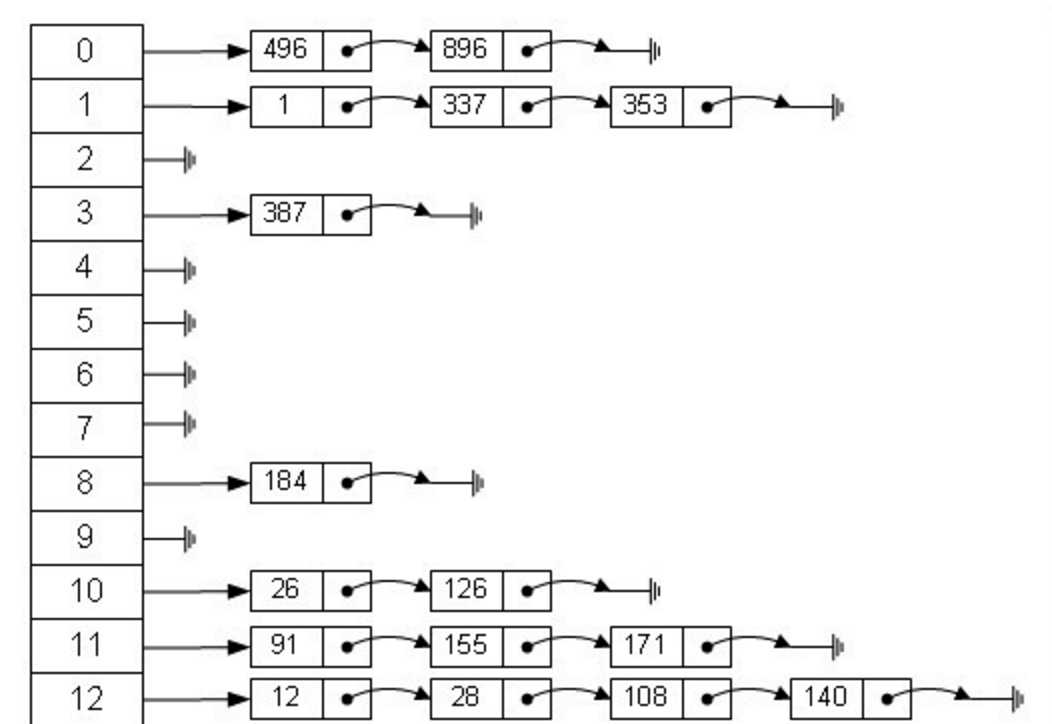之所以分两篇文章记录,因为之前一直看的1.7的源码,而且网上很多的都是关于1.7的,今天在1.8上打开源码一看,居然懵了。 没想到1.8的实现变化这么大。所有特地拿一篇文章来记录下。
本章只介绍1.7的情况
1.HashMap存储结构

哈希表是由数组+链表组成的,一个长度为16的数组中,每个元素存储的是一个链表的头结点。那么这些元素是按照什么样的规则存储到数组中呢。一般情况是通过hash(key)%len获得,也就是元素的key的哈希值对数组长度取模得到。比如上述哈希表中,12%16=12,28%16=12,108%16=12,140%16=12。所以12、28、108以及140都存储在数组下标为12的位置。当下标有冲突的时候,就需要解决冲突,目前解决冲突的方法有:
Java中的hashmap的解决办法就是采用的链地址法。
源码分析
数据结构
/**
* The table, resized as necessary. Length MUST Always be a power of two.,长度必须为2的指数次,为什么?其中非常重要的原因就是为了hash的平均分布
*/
transient Entry<K,V>[] table; //定义table数组,类型为Entry
static class Entry<K,V> implements Map.Entry<K,V> { //entry,即链表结构,存放key,value,next节点
final K key;
V value;
Entry<K,V> next;
int hash;
2.HashMap put方法
打个比方, 第一个键值对A进来,通过计算其key的hash得到的index=0,记做:Entry[0] = A。一会后又进来一个键值对B,通过计算其index也等于0,现在怎么办?HashMap会这样做:B.next = A,Entry[0] = B,如果又进来C,index也等于0,那么C.next = B,Entry[0] = C;这样我们发现index=0的地方其实存取了A,B,C三个键值对,他们通过next这个属性链接在一起。所以疑问不用担心。也就是说数组中存储的是最后插入的元素。
public V put(K key, V value) {
if (key == null)
return putForNullKey(value); //空值的put,放到index0的位置
int hash = hash(key);
int i = indexFor(hash, table.length); //获取Hash值对应的数组index
for (Entry<K,V> e = table[i]; e != null; e = e.next) { //获取数组index的entry,如果不为空则寻找下一个节点,直到到entry为null
Object k;
if (e.hash == hash && ((k = e.key) == key || key.equals(k))) { //如果key相同,则替换key的value,或者
V oldValue = e.value;
e.value = value;
e.recordAccess(this);
return oldValue;
}
}
modCount++;
addEntry(hash, key, value, i); //添加元素
return null;
}
void addEntry(int hash, K key, V value, int bucketIndex) {
if ((size >= threshold) && (null != table[bucketIndex])) { //如果超过装载因子的最大值,则需要对数组进行扩容
resize(2 * table.length);
hash = (null != key) ? hash(key) : 0;
bucketIndex = indexFor(hash, table.length); //获取hash对应的新的index
}
createEntry(hash, key, value, bucketIndex); //创建entry
}
/**
* Like addEntry except that this version is used when creating entries
* as part of Map construction or "pseudo-construction" (cloning,
* deserialization). This version needn‘t worry about resizing the table.
*
* Subclass overrides this to alter the behavior of HashMap(Map),
* clone, and readObject.
*/
void createEntry(int hash, K key, V value, int bucketIndex) {
Entry<K,V> e = table[bucketIndex]; //将当前数组index的节点保存
table[bucketIndex] = new Entry<>(hash, key, value, e); //数组index的值更新为新节点,之前的节点变为新节点的next节点;
size++;
}
3.HashMap get方法
public V get(Object key) { if (key == null) return getForNullKey(); //null值获取 Entry<K,V> entry = getEntry(key); return null == entry ? null : entry.getValue(); }
final Entry<K,V> getEntry(Object key) {
int hash = (key == null) ? 0 : hash(key); //求key的hash值
for (Entry<K,V> e = table[indexFor(hash, table.length)]; //在数组中查找hash值对应的下标
e != null;
e = e.next) {//如果entry不为null的情况下,继续遍历链表的下一个节点,直到查找到key相同,且hash值相同的,返回搜索结果
Object k;
if (e.hash == hash &&
((k = e.key) == key || (key != null && key.equals(k))))
return e;
}
return null;
}
/** * Offloaded version of get() to look up null keys. Null keys map * to index 0. This null case is split out into separate methods * for the sake of performance in the two most commonly used * operations (get and put), but incorporated with conditionals in * others. */ private V getForNullKey() { for (Entry<K,V> e = table[0]; e != null; e = e.next) { if (e.key == null) return e.value; } return null; }
4.HashMap扩容
/**
* Rehashes the contents of this map into a new array with a
* larger capacity. This method is called automatically when the
* number of keys in this map reaches its threshold.
*
* If current capacity is MAXIMUM_CAPACITY, this method does not
* resize the map, but sets threshold to Integer.MAX_VALUE.
* This has the effect of preventing future calls.
**/
void resize(int newCapacity) {
Entry[] oldTable = table;
int oldCapacity = oldTable.length;
if (oldCapacity == MAXIMUM_CAPACITY) { //判断是否达到最大容量
threshold = Integer.MAX_VALUE;
return;
}
Entry[] newTable = new Entry[newCapacity];
boolean oldAltHashing = useAltHashing;
useAltHashing |= sun.misc.VM.isBooted() &&
(newCapacity >= Holder.ALTERNATIVE_HASHING_THRESHOLD);
boolean rehash = oldAltHashing ^ useAltHashing;
transfer(newTable, rehash); //扩容,将原来的数据添加到新的数组中
table = newTable;
threshold = (int)Math.min(newCapacity * loadFactor, MAXIMUM_CAPACITY + 1);
}
/**
* Transfers all entries from current table to newTable.
*/
void transfer(Entry[] newTable, boolean rehash) {
int newCapacity = newTable.length;
for (Entry<K,V> e : table) {
while(null != e) {
Entry<K,V> next = e.next;
if (rehash) {
e.hash = null == e.key ? 0 : hash(e.key);
}
int i = indexFor(e.hash, newCapacity);
e.next = newTable[i];
newTable[i] = e;
e = next;
}
}
}
5.HashMap缺点
a.不支持多线程,即非线程安全;
原文:http://www.cnblogs.com/dpains/p/7162223.html